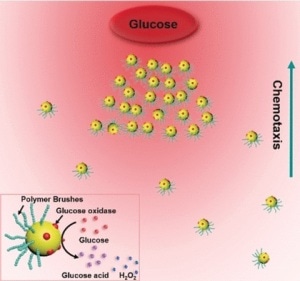Aug 1 2019
Bacteria have the ability to dynamically move toward a nutrient source—a phenomenon called chemotaxis—and they can move together through a process called swarming.
 (Image credit: Wiley-VCH)
(Image credit: Wiley-VCH)
Chinese researchers have redesigned collective chemotaxis by developing artificial model nanoswimmers from chemically and biochemically altered gold nanoparticles. The research reported in the journal Angewandte Chemie concludes that the model could help gain insights into the dynamics of chemotactic motility in a bacterial swarm.
What leads to swarming, and if such collective behavior can be converted into artificial intelligent systems, is presently an area of in-depth scientific study. A known fact is that bacteria swimming in a dense pack sense the nearby fluid differently from a solitary swimmer.
However, the rate at which the swimmers are sped up in a swarm, and other factors that play a role, is still ambiguous. Qiang He—colloidal chemist at the Harbin Institute of Technology, China—and his teammates have now built a simple artificial model of bacteria-like nanoswimmers.
They examined active chemotactic behavior and formation of the swimmers into a uniquely moving swarm.
He and his team built their artificial swimmers from small spheres of gold. The size of the gold nanoparticles was 40 times smaller than a usual bacterium, hence they were below the detection limit of the microscope.
However, due to a light-scattering phenomenon known as the Tyndall effect, the researchers could see larger variations in the solution that had swimmers, even with the naked eye. In addition, they resolved the orientation, speed, and concentration of the particles in finer detail using other analytical methods.
Researchers like to work with gold nanoparticles since the small spheres form a stable, disperse solution, which can be readily observed using an electron microscope, and molecules can adhere to them quite easily.
He and his colleagues first stacked the surface of large silica spheres with gold particles. Next, they affixed polymer brushes on the uncovered side of the gold spheres. These brushes were composed of polymer chains and were up to 80 nm long, thereby making the gold particles highly asymmetric.
The scientists dissolved the silica carrier and attached an enzyme on the exposed side of the gold spheres so that the resulting nanoparticles were embraced with long and thick polymer brushes on one side and with the enzyme on the other side. Glucose is broken down into a compound known as gluconic acid by the glucose oxidase enzyme in the presence of oxygen.
In order to find out whether the nanoswimmers would actively swim in a particular direction, the authors kept them at one end of a small channel and kept a permanent glucose source at the other end. Just like living bacteria, the model swimmers actively moved along the glucose gradient toward the glucose source.
This was not the only fact that was shocking, since enzymatically driven, self-propelling swimmers are well known from experiment and theory. However, the authors could also identify swarming behavior. The asymmetric nanoparticles concentrated into a separate phase that traveled collectively along the nutrient gradient.
The authors envision that the nanoswimmers could be further advanced as helpful and easily accessible physical models to explore the swarming and chemotactic behavior of living or non-living things on the nanoscale.